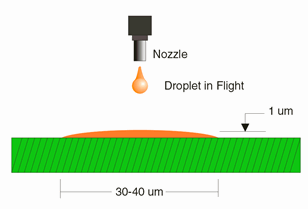
Simulating Surface Height and Roughness
of Ink Jetted Conductors


Antonio Morawski, Director of Software Development


Introduction
The direct application of conductors to a PCB using ink jet technology is of
great interest to circuit manufacturers. The ability to do this would eliminate
the need for masks, photoresist, developing, stripping, etching and cleaning.
We wish to discuss in particular the problem of building up sufficient thickness
in the conductors and in producing a smooth surface on the conductor traces.


When the droplet hits the substrate, it spreads out into a very flat pancake.
The diameter and thickness of the pancake vary, depending on the droplet
volume, the viscousity and the surface properties of the substrate, but for the
material and process we are familiar with, the diameter ranges from about 30 to
40 um and the thickness (after the solvent has evaporated) is approximately one
micron.


A one micron conductor is not thick enough to carry the electrical signal
without loss. Many overlapping passes have to be made to build up the conductor’s thickness. But multiple passes can introduce a new problem: surface roughness.


A smooth surface is important since high frequency signal losses increase with
surface roughness. Any inkjet conductors that do not have smooth surfaces will
not be suitable for today’s high frequency cell phone and wireless applications.





In the illustration above one can see that the inkjet conductors are not only
thinner than the etched ones but their surface may be considerable rougher
leading to high frequency signal losses.



















